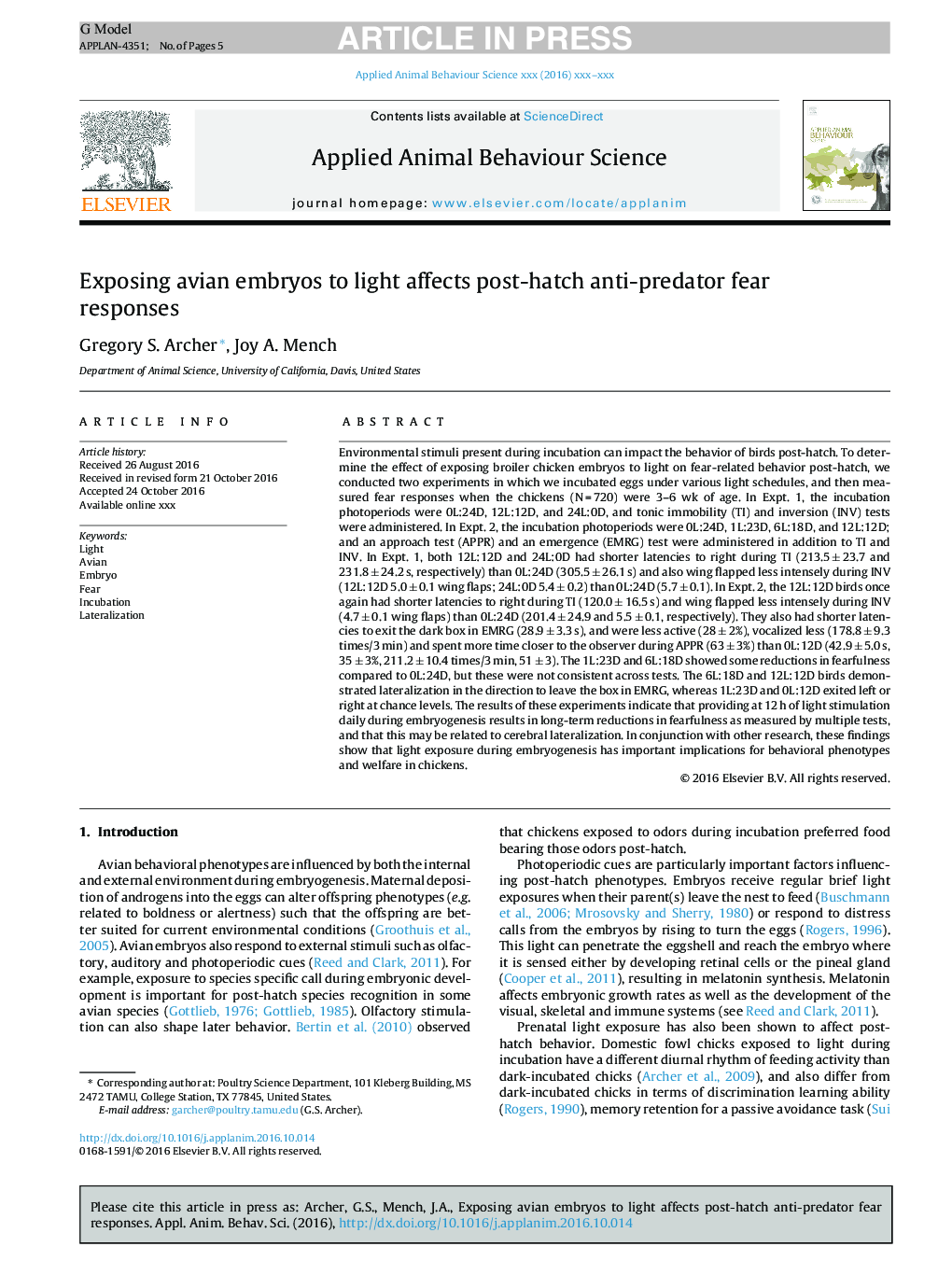| کد مقاله | کد نشریه | سال انتشار | مقاله انگلیسی | نسخه تمام متن |
|---|---|---|---|---|
| 5763387 | 1625320 | 2017 | 5 صفحه PDF | دانلود رایگان |
عنوان انگلیسی مقاله ISI
Exposing avian embryos to light affects post-hatch anti-predator fear responses
ترجمه فارسی عنوان
مواجهه ساختن جنین طیور با نور، بر واکنشِ ترس از شکارچی پس از تخم گشائی اثر میگذارد
همین الان دانلود کنید
دانلود مقاله ISI انگلیسی
رایگان برای ایرانیان
کلمات کلیدی
نور، طیور، جنین، ترس، انکوباسیون، جانبی شدن
فهرست مطالب مقاله
چکیده
کلمات کلیدی
1. مقدمه
2. مواد و روشها
2.1 حیوانات و رسیدگی به آنها
2.2. اندازه گیری ترس
2.3 تحلیل آماری
2.4 نتایج
2.4.1. عدم تحرک تونیک
2.5 آزمون وارونگی
2.6 آزمونهای نزدیک شدن و بیرون آمدن یا خروج
3. بحث
4. نتایج
شکلها و جدول
کلمات کلیدی
1. مقدمه
2. مواد و روشها
2.1 حیوانات و رسیدگی به آنها
2.2. اندازه گیری ترس
2.3 تحلیل آماری
2.4 نتایج
2.4.1. عدم تحرک تونیک
2.5 آزمون وارونگی
2.6 آزمونهای نزدیک شدن و بیرون آمدن یا خروج
3. بحث
4. نتایج
شکلها و جدول
ترجمه چکیده
محرکهای محیطی موجود در زمان انکوباسیون میتوانند بر رفتار طیور پس از تخم گشایی تأثیر بگذارند. جهت تعیین اثر مواجهه جنین مرغ گوشتی با روشنایی، بر رفتارهای ترس پس از تخم گشائی، دو آزمایش انجام دادیم. طی این آزمایشات تخمها را تحت برنامههای مختلف نوری انکوبه و وقتی جوجهها (N = 720) به سه تا 6 هفتگی رسیدند، پاسخهای ترس را اندازه گیری کردیم. در آزمایش یک، دورههای نوری انکوباسیون عبارت بود از: 0L:24D, 12L:12D, و 24L:0D، و سپس تستهای عدم تحرک تونیک (TI) و وارونگی یا واژگون سازی (INV) انجام شد. در آزمایش دوم، دورههای نوری انکوباسیون عبارت بود از : 0L:24D, 1L:23D, 6L:18D, and 12L:12D. علاوه بر TI و INV ، تست نزدیک شدن (APPR) و تست خروج یا بیرونآمدن (EMRG) نیز انجام شد. در آزمایش یک، 12L:12D و 24L:0D برای برخاستن در طول TI هر دو تاخیر کوتاهتر (به ترتیب 213.5 ± 23.7 و 231.8± 24.2 ثانیه) نسبت به 0L:24D (305.5 ± 26.1 ثانیه) و همچنین شدت بالزدن کمتری حین INV (12L:12D،
5.0 ± 0.1 بال زدن؛ 24L:0D، 5.4 ± 0.2 ) نسبت به 0L:24D (5.7 ± 0.1) داشتند. در آزمایش دوم، طیور انکوبه شده در12L:12D مجددا در TI تاخیرکوتاهتری در برخاستن (16.5 ± 120.0 ثانیه) و شدت بال زدن کمتری در طول INV (بال زدن 0.1 ± 4.7) نسبت به 0L:24D (به ترتیب201.4 ± 24.9 و 5.5 ± 0.1 ) داشتند. آنها همچنین برای خروج از جعبه تاریک در EMRG تأخیر کمتر (28.9 ± 3.3 ثانیه) و فعالیت کمتر (%2 ± 28)، و صدای کمتری داشتند (178.8 ± 9.3 بار در 3 دقیقه)، و حین APPR نسبت به 0L:12D زمان بیشتری را در نزدیکی ناظر سپری کردند (63 ± 3%)
موضوعات مرتبط
علوم زیستی و بیوفناوری
علوم کشاورزی و بیولوژیک
علوم دامی و جانورشناسی
چکیده انگلیسی
Environmental stimuli present during incubation can impact the behavior of birds post-hatch. To determine the effect of exposing broiler chicken embryos to light on fear-related behavior post-hatch, we conducted two experiments in which we incubated eggs under various light schedules, and then measured fear responses when the chickens (N = 720) were 3-6 wk of age. In Expt. 1, the incubation photoperiods were 0L:24D, 12L:12D, and 24L:0D, and tonic immobility (TI) and inversion (INV) tests were administered. In Expt. 2, the incubation photoperiods were 0L:24D, 1L:23D, 6L:18D, and 12L:12D; and an approach test (APPR) and an emergence (EMRG) test were administered in addition to TI and INV. In Expt. 1, both 12L:12D and 24L:0D had shorter latencies to right during TI (213.5 ± 23.7 and 231.8 ± 24.2 s, respectively) than 0L:24D (305.5 ± 26.1 s) and also wing flapped less intensely during INV (12L:12D 5.0 ± 0.1 wing flaps; 24L:0D 5.4 ± 0.2) than 0L:24D (5.7 ± 0.1). In Expt. 2, the 12L:12D birds once again had shorter latencies to right during TI (120.0 ± 16.5 s) and wing flapped less intensely during INV (4.7 ± 0.1 wing flaps) than 0L:24D (201.4 ± 24.9 and 5.5 ± 0.1, respectively). They also had shorter latencies to exit the dark box in EMRG (28.9 ± 3.3 s), and were less active (28 ± 2%), vocalized less (178.8 ± 9.3 times/3 min) and spent more time closer to the observer during APPR (63 ± 3%) than 0L:12D (42.9 ± 5.0 s, 35 ± 3%, 211.2 ± 10.4 times/3 min, 51 ± 3). The 1L:23D and 6L:18D showed some reductions in fearfulness compared to 0L:24D, but these were not consistent across tests. The 6L:18D and 12L:12D birds demonstrated lateralization in the direction to leave the box in EMRG, whereas 1L:23D and 0L:12D exited left or right at chance levels. The results of these experiments indicate that providing at 12 h of light stimulation daily during embryogenesis results in long-term reductions in fearfulness as measured by multiple tests, and that this may be related to cerebral lateralization. In conjunction with other research, these findings show that light exposure during embryogenesis has important implications for behavioral phenotypes and welfare in chickens.
ناشر
Database: Elsevier - ScienceDirect (ساینس دایرکت)
Journal: Applied Animal Behaviour Science - Volume 186, January 2017, Pages 80-84
Journal: Applied Animal Behaviour Science - Volume 186, January 2017, Pages 80-84
نویسندگان
Gregory S. Archer, Joy A. Mench,
